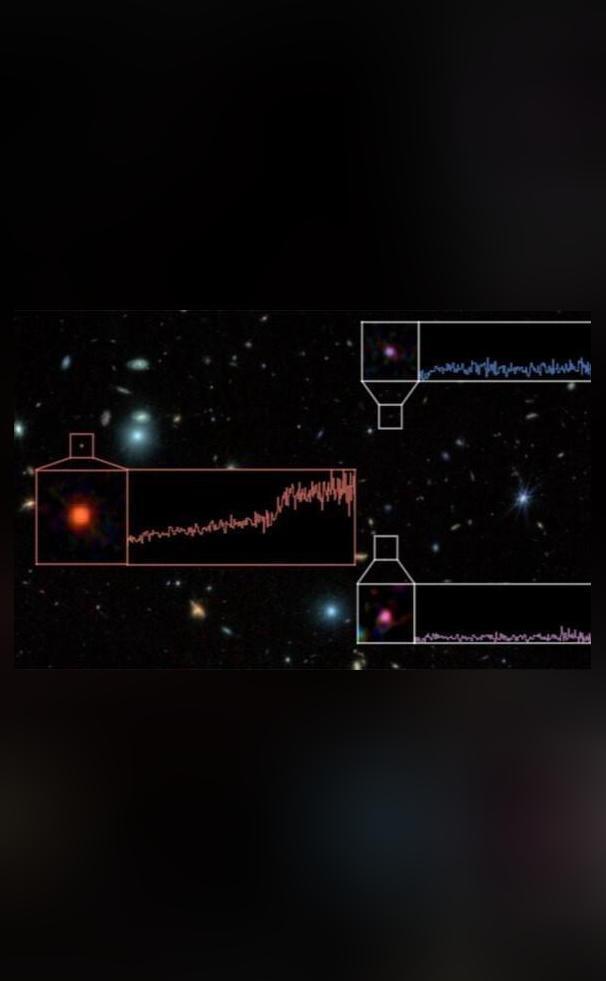
Astronomers Spot ‘Dead Galaxy’ That Has Stopped Forming Stars
The James Webb Space Telescope (JWST) has once again made a groundbreaking discovery in the field of astronomy. Recently, astronomers have spotted the most distant and massive ‘dead galaxy’ using the JWST. A galaxy that stops creating new stars is categorised as a ‘dead galaxy’. This fascinating find has sparked interest among scientists and astronomers worldwide, as it provides valuable insights into the evolution of galaxies.
The ‘dead galaxy’ in question is called RUBIES-UDS-QG-z7. It is a behemoth of a galaxy, with a mass of approximately 1.5 billion times that of our sun. The galaxy is situated about 13.4 billion light-years away, which means that the light we see from it today has been traveling through space for over 13 billion years. This is the farthest galaxy ever observed using the JWST, and it is a remarkable example of the incredible capabilities of this space telescope.
So, what does it mean for a galaxy to be ‘dead’? In simple terms, a galaxy is considered ‘dead’ when it stops forming new stars. This can occur due to various reasons, such as the depletion of gas and dust, the suppression of star formation, or the presence of dark matter. When a galaxy stops forming new stars, it means that it has reached the end of its star-forming life cycle.
The oldest known ‘dead galaxy’ was spotted in March last year, named JADES-GS-z7-01-QU. This galaxy stopped producing stars when the universe was just 700 million years old. The discovery of RUBIES-UDS-QG-z7 has now pushed back this timeline by another 3.6 billion years, providing further insight into the early universe.
The JWST has been instrumental in the discovery of RUBIES-UDS-QG-z7. The space telescope has been designed to observe the universe in infrared light, which allows it to peer through dust and gas, revealing the distant and hidden galaxies. The JWST uses a unique combination of instruments to study the light coming from distant galaxies, providing valuable information about their composition, size, and distance.
The discovery of RUBIES-UDS-QG-z7 is significant not only because of its distance and mass but also because it provides a unique window into the early universe. The galaxy is thought to have formed during the era of reionization, a period when the first stars and galaxies were forming. During this time, the universe was still in its early stages of development, with temperatures being much hotter than today.
The study of RUBIES-UDS-QG-z7 has provided astronomers with a glimpse into the early universe, offering insights into the formation and evolution of galaxies. The discovery has also sparked questions about the role of dark matter in the formation of galaxies. Dark matter is a mysterious substance that makes up approximately 27% of the universe, but its nature and properties are still not well understood.
The finding of RUBIES-UDS-QG-z7 has also shed light on the role of galaxy mergers in the evolution of galaxies. Galaxy mergers are events where two or more galaxies collide and merge, resulting in the formation of a new, more massive galaxy. The study of RUBIES-UDS-QG-z7 suggests that galaxy mergers may have played a significant role in the formation of this massive galaxy.
The discovery of RUBIES-UDS-QG-z7 is a testament to the incredible capabilities of the James Webb Space Telescope. The JWST is a powerful tool that has been designed to study the universe in unprecedented detail. With its ability to observe the universe in infrared light, the JWST has been able to peer through dust and gas, revealing the distant and hidden galaxies.
The study of RUBIES-UDS-QG-z7 is an ongoing process, with astronomers continuing to analyze the data collected by the JWST. As new discoveries are made, scientists are gaining a deeper understanding of the early universe and the formation and evolution of galaxies. The discovery of RUBIES-UDS-QG-z7 is a significant milestone in the field of astronomy, providing valuable insights into the distant past and the mysteries of the universe.




